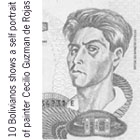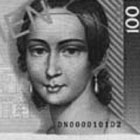
|
who do we value?
emmanuelle |
It appears banal. We've seen John A Macdonald's face so many times, we automatically assume he is the right face for the bill. And then the Queen, of course she should be on our bill. Humhum. | The prime ministers that have shaped our country at its very early stage merit the respect of tender, or do they? |
| As I ask myself this question, all I can think about is the Bernini and Carravaggio on the now passing away Italian Lira, and what kind of place we would be if we courageously placed Riopelle or Glen Gould on our bills. Or Margaret Atwood, someone of the present. | Curiosity brings me to other countries to see who it is they admire so much to place on their currency. Many countries follow the tradition of 'power' figures, displaying kings and queens, or figures of their political history, revolutionaries. | Tunisia portrayed for many years its leader of independence from France - Hagib Bourguiba, until recently moving to other notable figures, from Hannibal to a poet. |

|
| The US 'determined that portraits of Presidents of the United States have a more permanent familiarity in the minds of the public than any others', and thus chose presidents or other famous statements, the same since their original adoption in 1929. | India portrays Mohatma Gahndy on the Rupi. Other countries put forth artists, intellectuals or scientist - people who have contributed to either the intellectual or social life of their country. |
France, pre- Euro, clearly identified its
selection criteria: La nouvelle gamme française est fondée sur les grands thèmes qui caractérisent le XXe siècle dans notre inconscient collectif. |
Writer, musician, painter, engineer and scientists th figure for their contribution to the 20th century consiousness Débussy, Saint-Exupéry, Cézanne, Eiffel, Pierre et Marie Curie. |
| Even at times the person’s sex becomes a criteria. Germany specifies: The main motifs on the notes are portraits of major figures in German cultural and intellectual life from the 17th to the early 20th century. |
The criteria for selecting the persons depicted were a significant personal
achievement in the scientific or cultural field, their sex, their religious
affiliation and the regions of Germany with which they were
associated.
100 DeutchMarks shows Clara Shumann, pianist and composer --> |

|
Indeed, the sex becomes an important element as the final selection is even: the 5 Deutch Mark shows a woman writer (Bettina von Arnim),the 10 DM is a male astronomer (Carl Friedrich Gauss), the 20 DM is Annette von Droste-Hülshoff, a poetess, every note alternating between a man and a woman. |

|
français |


|